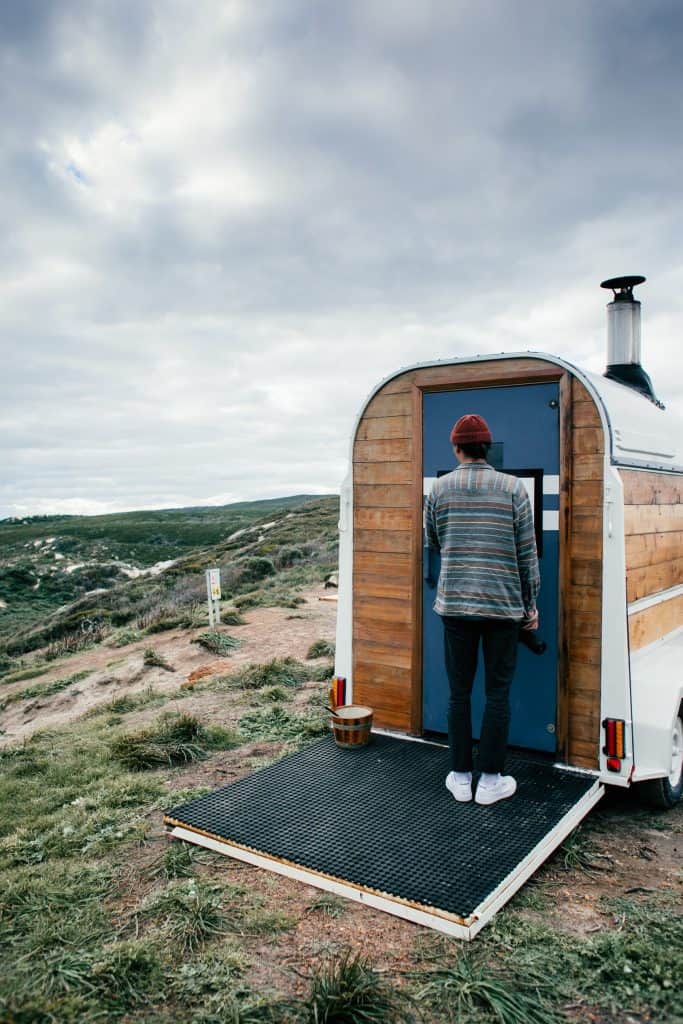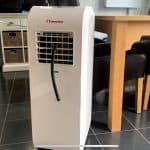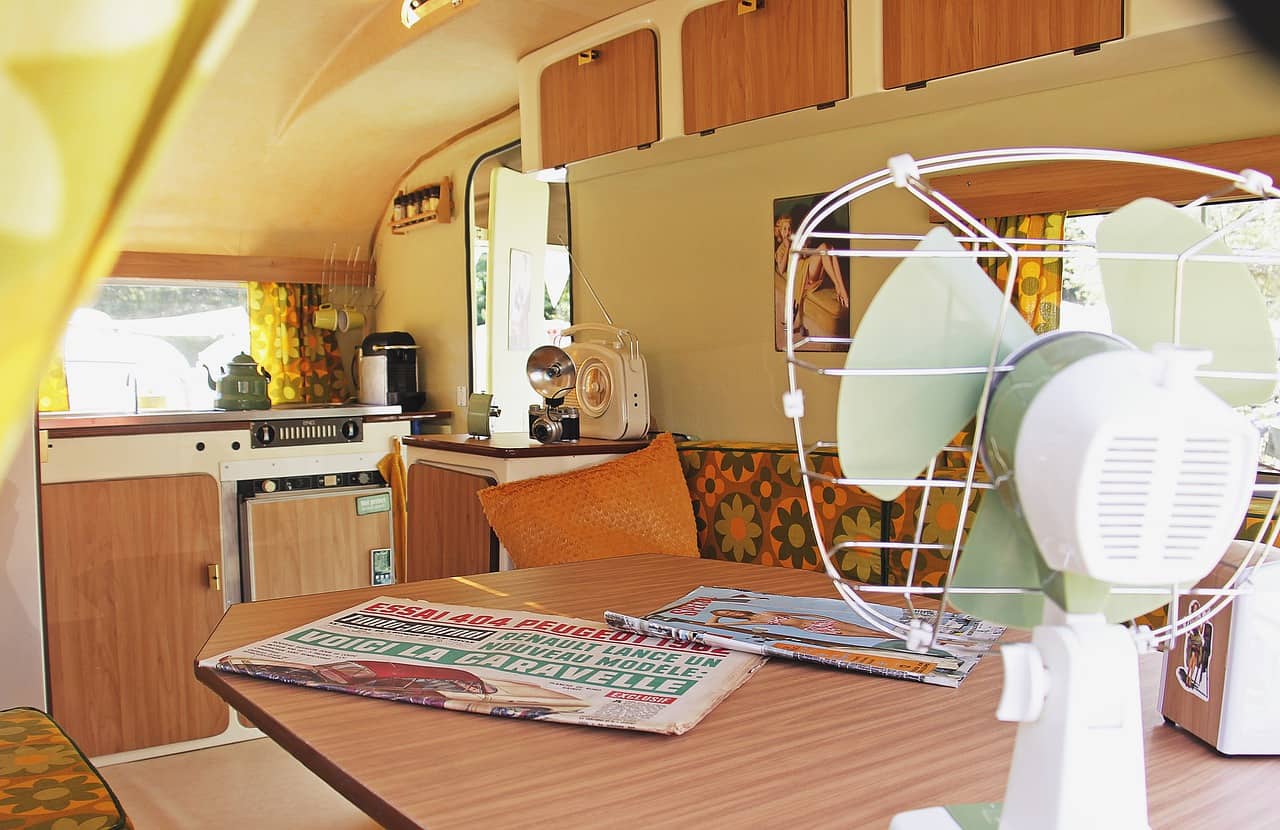Small spaces like enclosed trailers and RVs heat up quickly when the outside temperature is high. Using a portable air conditioner can be a simple and effective way to cool down the space.
The best portable air conditioner for an enclosed trailer or RV must possess certain qualities. Due to the limited space in these vehicles, the AC must be compact and easy to store when not in use. It must also be easy to vent and have the ability to cool a space quickly.
Portable air conditioners are all used for the same purpose, but there’s a lot of variation out there.
The components, materials, dimensions, and power requirements differ depending on the manufacturer and the model.
In this guide, we’ll cover all of the vital information regarding enclosed trailers and portable air conditioners, and present some of the best options for you to consider.

How Do You Cool an Enclosed Trailer?
Enclosed trailers allow you to experience many home comforts on your travels. One of the most appealing things about them is that you can customize the layout to suit your needs and create a unique space to travel and rest in.
To make the enclosed trailer as comfortable as possible, it’s essential to keep it at an optimal temperature.
If the weather outside is hot, this will heat the structure and cause the internal temperature to rise, which is something that needs to be addressed.
Simple measures like opening a window or door may provide temporary cooling, but inevitably the heat from outside will make its way into the enclosed trailer.
It’s therefore essential to have a device in the trailer which can quickly and effectively cool it down. There are a few options that you could use, which include:
- Portable air conditioners
- Window air conditioners
- Fixed air conditioners
Window and fixed air conditioners are generally quite pricey, and they require you to physically install them in the enclosed trailer. Consequently, I’d recommend considering a portable AC as they can be moved around and are much easier to operate.
Cooling an enclosed trailer with a portable air conditioner is quite straightforward. The AC uses a compressor and refrigerant to extract the warmth and moisture from the air, then outputs this air through a vent so that it is not circulated back into the space.
This causes the overall temperature inside the enclosed trailer to drop in a short space of time.
Fixed and window ACs essentially do the same thing, but they cannot be moved around the enclosed trailer nor can they be removed easily when they are not required.
Some rare portable air conditioners do not require venting, but they are usually less effective at cooling down a space.
- Ideally, you’ll need a suitable place to vent the hot air from the AC to prevent it from being reintroduced, which would limit the effectiveness of the cooling process.
To use a portable air conditioner in an enclosed trailer or RV, you’ll need to consider how you’re going to supply power to it, how you’re going to vent the hot air and the best way to store it when it is not in use. This video provides some useful tips on the subject.
How to Vent a Portable Air Conditioner in an RV
Venting a portable air conditioner in an RV is usually quite straightforward, but it depends on the materials and building specifics of the vehicle.
Many modern RVs are made from fiberglass. This material is expensive and therefore making a hole in it should be avoided.
You’ll first need to locate the best-suited position to vent your portable AC in the RV.
This may be through the floor if there are no better options available. Alternatively, you can vent the AC through the wall or even the roof, but this should be a last resort.
Once you’ve decided on the best place to vent the hot air, you’ll need to measure the space to check that the portable air conditioner can be placed there without impeding your movement in the RV.
Next, measure the vent from the portable air conditioner accurately so that you can make a hole that it will fit into. It’s a good idea to check the RV manual to avoid cutting through any pipes, cables, or other hidden components when making the hole for the vent.
Ensure that the power is turned off so that you avoid cutting into a live cable or wire. Then, draw the holes for the vent and check them against the measurements to ensure you cut them accurately.
After cutting the holes, you can feed the vent through. Make sure that the hot air is expelled outside the RV, otherwise, it will come back into the space and limit the effectiveness of the device.
Use tape or another sealant to secure the ventilation hose in the holes, and make sure that the whole unit isn’t going to move around when you are driving the RV.
It’s then time to turn on the portable AC and check that it is working with the hot air going through the vent, out of the hole, and outside of the vehicle.
If you’re not experienced or confident it might be a good idea to ask a professional or someone who has the skills to do this to help you. Cutting a hole in your RV needs to be done correctly or you could damage the structure of the vehicle.
Best Portable AC For Enclosed Trailer or RV
In our opinion, the Black and Decker BPACT10WT is the best portable air conditioner available.
Here is a list of the key features of this portable AC:
- 24-hour timer
- Sleep Mode or automatic air control during the night
- 10,000 BTU cooling power
- 3 fan power levels
- 5” x 11.5”
This portable air conditioner is highly effective in small to medium spaces, ranging from 150 to 150 square feet. It’s also very compact, making it easy to store away in the winter months.
The process of setting up the BPACT10WT is also very simple, as it comes with all of the necessary hardware and components.
Another feature we found impressive is the self-evaporation which means you don’t need to constantly empty the drain pan as the AC extracts moisture from the air. The air filter is reusable, so you can easily clean it after use.
This air conditioner is ideal for RVs and enclosed trailers, as it is easy to vent and produces low noise. You can also control it using the included remote control.
Do You Have to Vent a Portable AC for a Trailer RV?
When using a conventional portable AC in a trailer or RV, unfortunately, there is no alternative to venting the hot air outside.
If the air cannot be vented, it will recirculate around the space. This will gradually heat the temperature and counteract the purpose of the AC, rendering it ineffective and wasting power.
Fans can provide a cooling effect, but they are nowhere near as effective as portable air conditioners and therefore shouldn’t be considered a viable alternative.
- There is, however, one alternative solution that doesn’t require venting.
Ventless portable air conditioners are designed to create airflow within a space, but they aren’t as effective at lowering the room temperature as vented ACs.
These devices are also commonly known as “evaporative coolers”. Unlike vented portable air conditioners, they don’t use a compressor or refrigerant and therefore no hot air is collected that needs to be vented out through a hose.
Many ventless portable coolers are low-power devices that can be connected to a USB port in an RV or trailer. Due to their low-power design, they can’t be expected to cool down the space like a higher power portable air conditioner would.
The table below shows the key differences between ventless air coolers and portable air conditioners:
| Capability | Portable Air Conditioner | Ventless Air Cooler |
| Energy consumption | High | Low |
| Temperature lowering | Yes | No |
| Noise volume | Moderate | Low |
| Maintainance | Filter cleaning | Water refill |
Despite their limitations, evaporative coolers may be useful if your RV or trailer doesn’t get up to exceedingly high temperatures, but does require a little cooling in the summer months.
If you’re set on using a portable air conditioner then you’ll need to vent it, otherwise, it simply won’t work. While this may be inconvenient, it’s a small price to pay to enjoy the efficient cooling and temperature management that these devices provide.
Related Questions
Can you use a solar panel battery to run a portable AC?
To successfully run a medium-sized portable air conditioner you will need around 1,800 watts of solar panel power. This will allow you to run the AC without any issues.
Do portable air conditioners produce carbon monoxide?
Portable air conditioners don’t produce carbon monoxide, so there’s no need to worry about this. They are very safe to use in enclosed spaces and will not cause pollution or be harmful in any way.
Do portable air conditioners reduce humidity?
While the primary purpose of a portable air conditioner is to cool down the temperature of a room, they also remove some moisture from the air. However, this will not significantly lower the overall humidity of the room.
Small spaces like enclosed trailers and RVs heat quickly when the outside temperature is high. Using a portable air conditioner can be a simple and effective way to cool down the space.
The best portable air conditioner for an enclosed trailer or RV must possess certain qualities. Due to the limited space in these vehicles, the AC must be compact and easy to store when not in use. It must also be easy to vent and have the ability to cool a space quickly.
Portable air conditioners are all used for the same purpose, but there’s a lot of variation out there.
The components, materials, dimensions, and power requirements differ depending on the manufacturer and the model. In this guide, we’ll cover all of the vital information regarding enclosed trailers and portable air conditioners, and present some of the best options for you to consider.
Simple measures like opening a window or door may provide temporary cooling, but inevitably the heat from outside will make its way into the enclosed trailer.
It’s therefore essential to have a device in the trailer which can quickly and effectively cool it down. There are a few options that you could use, which include:
- Portable air conditioners
- Window air conditioners
- Fixed air conditioners
Window and fixed air conditioners are generally quite pricey, and they require you to physically install them in the enclosed trailer. Consequently, I’d recommend considering a portable AC as they can be moved around and are much easier to operate.
Cooling an enclosed trailer with a portable air conditioner is quite straightforward. The AC uses a compressor and refrigerant to extract the warmth and moisture from the air, then outputs this air through a vent so that it is not circulated back into the space.
This causes the overall temperature inside the enclosed trailer to drop in a short space of time. Fixed and window ACs essentially do the same thing, but they cannot be moved around the enclosed trailer nor can they be removed easily when they are not required.
Some rare portable air conditioners do not require venting, but they are usually less effective at cooling down a space. Ideally, you’ll need a suitable place to vent the hot air from the AC to prevent it from being reintroduced, which would limit the effectiveness of the cooling process.
To use a portable air conditioner in an enclosed trailer or RV, you’ll need to consider how you’re going to supply power to it, how you’re going to vent the hot air and the best way to store it when it is not in use. This video provides some useful tips on the subject.
How to Vent a Portable Air Conditioner in an RV
Venting a portable air conditioner in an RV is usually quite straightforward, but it depends on the materials and building specifics of the vehicle.
Many modern RVs are made from fiberglass. This material is expensive and therefore making a hole in it should be avoided.
You’ll first need to locate the best-suited position to vent your portable AC in the RV. This may be through the floor if there are no better options available. Alternatively, you can vent the AC through the wall or even the roof, but this should be a last resort.
Once you’ve decided on the best place to vent the hot air, you’ll need to measure the space to check that the portable air conditioner can be placed there without impeding your movement in the RV.
Next, measure the vent from the portable air conditioner accurately so that you can make a hole that it will fit into. It’s a good idea to check the RV manual to avoid cutting through any pipes, cables, or other hidden components when making the hole for the vent.
Ensure that the power is turned off so that you avoid cutting into a live cable or wire. Then, draw the holes for the vent and check them against the measurements to ensure you cut them accurately.
After cutting the holes, you can feed the vent through. Make sure that the hot air is expelled outside the RV, otherwise, it will come back into the space and limit the effectiveness of the device.
Use tape or another sealant to secure the ventilation hose in the holes, and make sure that the whole unit isn’t going to move around when you are driving the RV.
It’s then time to turn on the portable AC and check that it is working with the hot air going through the vent, out of the hole, and outside of the vehicle.
If you’re not experienced or confident it might be a good idea to ask a professional or someone who has the skills to do this to help you. Cutting a hole in your RV needs to be done correctly or you could damage the structure of the vehicle.
Best Portable AC
In our opinion, the Black and Decker BPACT10WT is the best portable air conditioner available.
Here is a list of the key features of this portable AC:
- 24-hour timer
- Sleep Mode or automatic air control during the night
- 10,000 BTU cooling power
- 3 fan power levels
- 5” x 11.5”
This portable air conditioner is highly effective in small to medium spaces, ranging from 150 to 150 square feet. It’s also very compact, making it easy to store away in the winter months.
The process of setting up the BPACT10WT is also very simple, as it comes with all of the necessary hardware and components.
Another feature we found impressive is the self-evaporation which means you don’t need to constantly empty the drain pan as the AC extracts moisture from the air. The air filter is reusable, so you can easily clean it after use.
This air conditioner is ideal for RVs and enclosed trailers, as it is easy to vent and produces low noise. You can also control it using the included remote control.
Do You Have to Vent a Portable AC for a Trailer RV?
When using a conventional portable AC in a trailer or RV, unfortunately, there is no alternative to venting the hot air outside.
If the air cannot be vented, it will recirculate around the space. This will gradually heat the temperature and counteract the purpose of the AC, rendering it ineffective and wasting power.
Fans can provide a cooling effect, but they are nowhere near as effective as portable air conditioners and therefore shouldn’t be considered a viable alternative.
There is, however, one alternative solution that doesn’t require venting. Ventless portable air conditioners are designed to create airflow within a space, but they aren’t as effective at lowering the room temperature as vented ACs.
These devices are also commonly known as “evaporative coolers”. Unlike vented portable air conditioners, they don’t use a compressor or refrigerant and therefore no hot air is collected that needs to be vented out through a hose.
Many ventless portable coolers are low-power devices that can be connected to a USB port in an RV or trailer. Due to their low-power design, they can’t be expected to cool down the space like a higher power portable air conditioner would.
The table below shows the key differences between ventless air coolers and portable air conditioners:
| Capability | Portable Air Conditioner | Ventless Air Cooler |
| Energy consumption | High | Low |
| Temperature lowering | Yes | No |
| Noise volume | Moderate | Low |
| Maintainance | Filter cleaning | Water refill |
Despite their limitations, evaporative coolers may be useful if your RV or trailer doesn’t get up to exceedingly high temperatures, but does require a little cooling in the summer months.
If you’re set on using a portable air conditioner then you’ll need to vent it, otherwise, it simply won’t work. While this may be inconvenient, it’s a small price to pay to enjoy the efficient cooling and temperature management that these devices provide.
Related Questions
Can You Lay A Portable Air Conditioner On It’s Side?
We have written an article on this subjrst. You can read it here.
Can you use a solar panel battery to run a portable AC?
To successfully run a medium-sized portable air conditioner you will need around 1,800 watts of solar panel power. This will allow you to run the AC without any issues.
Do portable air conditioners produce carbon monoxide?
Portable air conditioners don’t produce carbon monoxide, so there’s no need to worry about this. They are very safe to use in enclosed spaces and will not cause pollution or be harmful in any way.
Do portable air conditioners reduce humidity?
While the primary purpose of a portable air conditioner is to cool down the temperature of a room, they also remove some moisture from the air. However, this will not significantly lower the overall humidity of the room.




